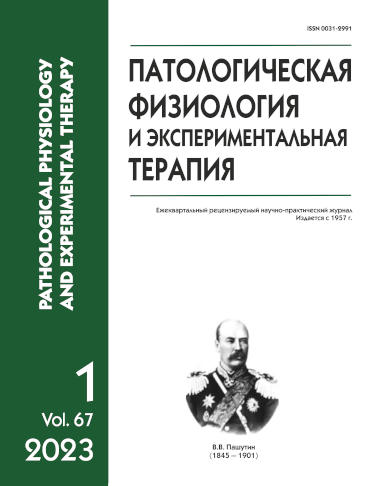Glutamate and ischemia-induced changes in ion homeostasis in the neuronal culture and cerebral cortex of mice expressing Ca²⁺-sensor GCаMP6f
Abstract
Relevance. In studies of brain intracellular and intercellular signaling in normal and pathological conditions, transgenic animals expressing a fluorescent Ca2+ sensor in neurons are increasingly used. Calcium homeostasis was studied in detail in primary neuroglial cultures, which serve as model systems of the living brain. But how change in calcium homeostasis during ischemic conditions in the intact brain correlate with experiments on cell cultures has been poorly studied so far. The aim of this work was to compare ischemia-driven changes in the intracellular concentration of Ca2+ ([Ca2+]) in vivo and in vitro: in the brain of transgenic mice, using the GCaMP6f fluorescent protein sensor, and in the neuroglial cell culture, obtained from the cortex of these animals. Methods. Changes in the cytosolic concentration of free Ca2+ ([Ca2+]c) in the neurons was measured by wide-field optical imaging (WFOI). Measurements were taken before and after photothrombotic stroke performed in the sensorimotor cortex. Changes in [Ca2+]c were monitored by the fluorescence of GCaMP6f expressed in cortical neurons. In primary neuroglial cultures from the cerebral cortex glutamate (Glu) in excitotoxic doses was used to model ischemic injury. Measurements of averaged Ca2+ concentration in the cyto- and nucleoplasm ([Ca2+]i) were carried out by fluorescence microscopy using synthetic Ca2+ indicators Fura-2 and Fura-FF. In addition, measurements of intracellular pH (pHi) and mitochondrial potential (ΔΨm) were carried out in vitro. Results. Photothrombotic stroke caused a strong increase in [Ca2+]c in the illuminated zone ~1.1 mm2 (n=9). During the 24 hours, the area with high [Ca2+]c expands to ~6 mm2, but by the 7th day it almost returns to the size of the primary damage. In neuroglial cultures from the cerebral cortex of the same mice strain, the [Ca2+]c kinetics measured by GCaMP6f resembles the [Ca2+]i kinetics, but [Ca2+]c has a significantly lower amplitude during the development of delayed calcium deregulation (DCD). Comparison of changes in [Ca2+]i and pHi shows that the differences may be due to the quenching of GCaMP6f fluorescence due to cytosol acidification as a result of the excitotoxic Glu action. Conclusion. Comparison of measurements by the genetically-encoded GCaMP6f Ca2+ sensor in vivo and by the synthetic Ca2+ indicators in primary neuroglial cultures shows that the DCD phenomenon, first discovered in cultures, is probably realized in intact brain neurons in stroke. It should be taken into account that the relative changes in [Ca2+]c can be distorted due to the effect of pHi on the fluorescence of the protein sensor at different stages of ischemia development and subsequent brain recovery after a photothrombotic stroke.






